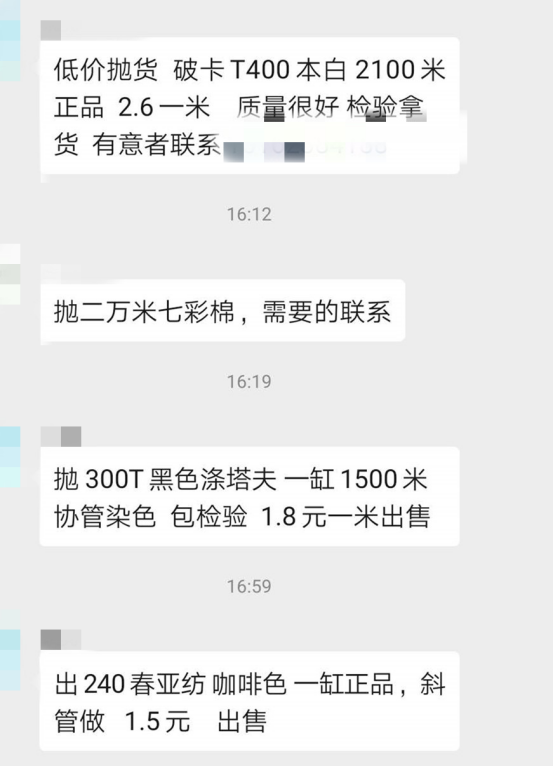Sales, especially sales at low prices, have always been a topic that textile people do not want to face. Because once the goods are sold, they will often fall into a passive position. On the one hand, it shows that they are currently lacking orders, and on the other hand, it is also a manifestation of the company’s lack of funds. Moreover, if the customer knows that the relevant company will sell the goods when it encounters difficulties, it will often lower the price indefinitely, no matter how low the price you sell the goods is.
Sell goods at low prices

However, this year’s textile market no longer allows textile people to consider too much “face”. Selling goods, selling goods in large quantities, and selling goods with clearly marked prices have begun to become sparse and common.
210T polyester taffeta black 1.65 yuan/meter, 240T pongee original white 1.9 yuan/meter, 300T pongee original white 2 yuan/meter, 50D high elastic pongee 2.5 yuan/meter, 75D high elastic pongee 2.5 yuan/meter…
This Each price is the price of the finished product. Anyone familiar with the textile fabric market knows how low these prices are. In the past two years, you may not even be able to buy the gray fabrics of these fabrics at these prices, but this year you have to “squeal” everywhere to find buyers for the finished product prices, and they may not be available in a short time, because you are not the only one selling goods. , of course you are not the only one with low prices.
This year’s textile workers are no longer selling cloth, but “exchanging cloth for money.” If you can have a customer come to pick up your cloth, you will be “grateful”. As for how much one meter of cloth costs, That’s something to talk about later. After all, fabrics cannot be used to pay rent, let alone pay wages to employees. Only by converting them into money can we keep the company running. And if you change it late, you may get less money in exchange, so many textile companies began to rush to sell their fabrics. In the face of survival and the industry-wide selling of goods, selling goods at low prices is no longer so unspeakable. Selling goods at low prices will inevitably have many impacts.
The finished product market has been impacted, and market orders have dropped significantly
Whether the textile market is good or bad, the impact of ordinary order fabrics is quite limited. After all, the order volume Relatively small, but a large number of market orders are the main role in determining market conditions.
But this year, the textile market has been in a situation of lack of market orders throughout the first half of the year. Although there was a trend of placing market orders in early May, the stamina of this wave of orders was seriously insufficient. The market did not even last until June, and the order volume was not at the same order of magnitude as in previous years.
Although the lack of market orders is inseparable from the shrinking demand caused by the epidemic, it is also because the market is flooded with the impact of selling fabrics. The finished product market, which is accustomed to stocking up in advance, is helpless when encountering a sharp drop in the prices of raw materials and gray fabrics. Fortunately, most of the common throw-away fabrics on the market are black and white, and the finished product market can also rely on varieties and colors that others do not have to win. However, the shipping speed of fabrics and profits will inevitably slow down and decrease.
However, selling goods at low prices also has its benefits, that is, downstream traders and customers can get some respite.
Customers like the quality of orders and low prices.
There are many weaving companies in the market that sell goods. While showing off various fabrics and prices, one thing is also mentioned: “order quality.” Adding these four words to the fabrics makes the difference, which means that these fabrics are not only extremely low-priced, but also of guaranteed quality. This is the “high-quality and low-priced” fabric that all customers want to see. In the past, it was difficult to balance price and quality, but this year these can be perfectly combined.
This is good news for downstream clothing customers and fabric traders. Today’s orders in the market, no matter how large or small, basically have requirements for fabric quality. At the same time, the epidemic this year has caused the profits of most textile and garment companies to decline, and the pursuit of low-cost operation will inevitably be put on the agenda. Price and quality are still valued at the moment, and the low-price sales in the market are in line with the current market demand and will inevitably play a certain role in promoting orders in the market.
The various low prices “all over the mountains and plains” are, to some extent, hitting the finished fabric market , and affect the confidence of these business owners, reducing the placement of market orders. But at the same time, it also gives downstream textile customers a little benefit, allowing them to obtain some low-priced and high-quality fabrics amid the shrinking orders caused by the epidemic, thereby attracting customers, stabilizing customers, and ultimately getting through the difficulties. </p






